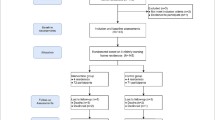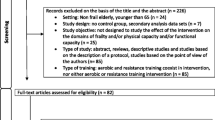Abstract
Objective
Although exercise therapy intervention for frail elderly people was not of great interest in the past, it has recently drawn attention as a method to prevent and improve conditions requiring care since the enforcement of the Long-Term Care Insurance Law and the revision of the long-term care insurance system. This randomized controlled trial was performed to evaluate the effects of exercise therapy using the Takizawa Program.
Methods
In this randomized controlled trial, we evaluated the effects of exercise therapy on the frail elderly, including those who need a high level of care, in terms of two factors: the range of motion and the functional independence measure. The subjects were 145 females admitted to special nursing homes for the elderly. They were stratified according to their care levels and randomly assigned to either the exercise therapy intervention group or the control group.
Results
The range of motion values in the flexions of both shoulders, the right knee extension, and the dorsal flexions of both ankles significantly increased only in the exercise therapy intervention group. The functional independence measure score did not improve in the exercise therapy intervention group.
Conclusion
Exercise therapy should be used for the frail elderly requiring a high level of care.
Similar content being viewed by others
References
Chino N. Investigation into the actual condition of rehabilitation medicine for chronic cerebral vascular accident. Nagoya, Japanese Foundation for Aging and Health, 2002. (Article in Japanese)
Japanese Physical Therapy Association (ed.) The Report on the Ability of Activity of Daily Living in Elderly People and Rehabilitation Care. Tokyo Japanese Physical Therapy Association; 2004. (Article in Japanese)
Yamazaki H. A study of the effect of rehabilitation training for the physically disabled in hospital. Journal of Transportation Medicine. 2002; 56: 12–18. (Article in Japanese)
Hosoe M, Takahasi Y, Matsuo A, Nisiwaki M. Rehabilitation of chronic stroke elderly patients. Gero onsen hospital annual report. 2001; 28: 1–6. (Article in Japanese)
Kusakabe K, Arata S, Nisiwaki M, Kiriyama K, Maeda K, Shimura I, et al. Effect of medical rehabilitation for chronic stroke patients. Gero onsen hospital annual report. 2000; 27: 79–82. (Article in Japanese)
Health and Welfare Statistics Association (ed.) Journal of Health and Welfare Statics. 2005; 52: 173–184 (Article in Japanese)
Morita H, Sionaka M, Hurui T, Miyakawa Y, Shimada T. The psychology and environmental factor affecting the gaps between capability ADL and performance ADL in the homebound post stroke hemiplegic elderly-analysis by structural equation model. Sogo Rehabilitation. 2003; 31: 167–174. (Article in Japanese)
Sakurada M, Suzuki S, Asanuma T, Asanuma T, Chiba M, Nanami T, Uemura S. The analysis of difference between the residents in health service facility for aged-who do and don’t to do daily activity. The Akita Journal of Physical Therapy. 2002; 10: 47–50. (Article in Japanese)
Fukuya Y. Disuse syndrome and physical therapy for the disabled living at home. The Japanese Journal of Physical Therapy. 1995; 29: 852–857. (Article in Japanese)
Society for the Study of Rehabilitation in the 21st century (ed.) Re-acquirement of the Gait of Bedridden Elderly. Fujisawa, Civil; 1996. (Article in Japanese)
Takizawa S, Kimura T, Kijima H, Okamoto Y, Nagaoka K, Morita Y, et al. Biophilia rehabilitation and proposition of the solution to the aging crisis. International Society of Physical and Rehabilitation Medicine. 2001: 729–734.
Takizawa S, Kimura T, Kijima H, Okamoto Y, Nagaoka K, Kanai Y, et al. Ambulation from bedridden. International Society of Physical and Rehabilitation Medicine. 2001; 747–752.
Takizawa S. An application of the civil technology to the sustainable aged society. Biophilia Rehabilitation Journal. 2004; 2: 1–24.
Usizawa K, Takizawa S, Nagasawa H, Makita M, Kimura T, Takizawa K. Statistical evaluation of rehabilitation to the disabled elderly based Takizawa-program. Biophilia Rehabilitation Journal. 2004; 2: 71–80.
Morita Y. Clinical evaluation of new type of walker with a seat and two fore sleds. Biophilia Rehabilitation Journal. 2004;2:51–56.
Data management service of the uniform data system for medical rehabilitation and the center for functional assessment research. Guide for use of the uniform data set for medical rehabilitation. New York: State University of New York; 1990.
Saitoh E. New assessment tool for stroke, FIM and SIAS. Journal of Clinical and Experimental Medicine. 1992; 163: 275–291. (Article in Japanese)
Watanabe H. The range of motion of the extremities in healthy Japanese people. Journal of Orthopedic Science. 1979; 53: 275–291. (Article in Japanese)
Okabe T, Watanabe H, Amano T. The range of motion of the extremities in healthy Japanese people—The differences according to the sex. Sogo Rehabilitation. 1980; 8: 41–56. (Article in Japanese)
Endo S, Makita M, Nagasawa H, Takizawa K, Kobayasi K, Shoji K. Rehabilitation training with two simple machines. Proceeding of 13th International Congress of World Confederation for Physical Therapy. 1999; 539.
Nakamura T. Joint contracture. Japanese Journal of Geriatric Psychiatry. 2002; 13: 360–365. (Article in Japanese)
Sayama I. Current status of post-stroke patients at home and follow-up results of their sequential functional changes. Sogo Rehabilitation. 1998; 26: 1127–1134. (Article in Japanese)
Nakamura R. Functional Assessment and Prognosis of the Stroke. Tokyo: Ishiyaku; 1997. (Article in Japanese)
Sunakoda A. Prediction of functional state in stroke patients living at home. Sogo Rehabilitation. 1998; 26: 1119–1125. (Article in Japanese)
Author information
Authors and Affiliations
Corresponding author
Rights and permissions
About this article
Cite this article
Makita, M., Nakadaira, H. & Yamamoto, M. Randomized controlled trial to evaluate effectiveness of exercise therapy (Takizawa Program) for frail elderly. Environ Health Prev Med 11, 221–227 (2006). https://doi.org/10.1007/BF02898010
Received:
Accepted:
Issue Date:
DOI: https://doi.org/10.1007/BF02898010




